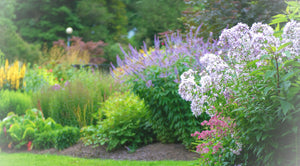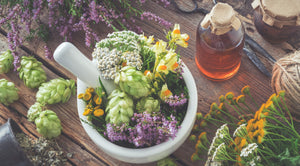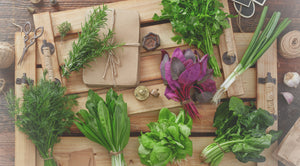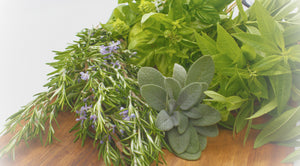Eucalyptus

Full sun is a must for Eucalyptus. It needs to dry completely before waterings, and avoid humid conditions. Do not mist the foliage.
Hardy between Zones 7 and 11 (but it must be given winter protection, and planted out of the wind), Eucalyptus must be brought indoors before any threat of frost. It will grow indoors in a container, but must be given 6-8 hours of direct sunlight. A monthly feeding of a well-balanced fertilizer is suggested for indoor growing.
Although Eucalyptus does not have a lot of ‘issues’, the one area of concern is fungus. It is susceptible to Silver Leaf, a fungal disease usually caused by pruning. The most effective, non-chemical method of dealing with this threat is to prune your Eucalyptus in the summer, when fewer spores are produced and pruning wounds (which are the entry point for spores) heals much faster.
Give proper care, Eucalyptus can grow into a gorgeous, stand along specimen tree that is outstanding in the garden.
Holy Basil

Since this plant is so important – a sacred herb and necessary to Hindu traditions – it is important to grow it successfully indoors.
Holy Basil is a tropical herb – they cannot survive a frost. Therefore, if you are unable to leave this plant outdoors because of your climate, care must be taken in growing it as a houseplant.
These tender herbs prefer daytime temperatures between 77 and 86 degrees. The nighttime temperatures must be above 55 degrees. 6 to 8 hours of sunlight is essential and it is important to rotate the pot so that the plant grows evenly.
Allow the soil to dry out between waterings, and always use a well-draining potting soil. When growing indoors, keep an eye out for spider mites. They live on the undersides of the leaves, and suck on the plant's juices leaving tell-tale tiny white spots. These pests thrive in hot and dry conditions, so make sure to mist your plants regularly.
If you do have a problem, you can control it with a soap spray:
-
Dissolve 1 -2 tablespoons of mild flaked soap (Ivory) in a gallon of warm water
-
Spray the plants weekly, making sure to spray the undersides of the leaves
When the weather allows, take your plants outdoors as they will thrive!
Lavender

To grow Lavender successfully, you need to understand its origins: a native of the Mediterranean, Lavender loves dry, sunny and rocky habitats. Don't worry! Lavenders will grow in many types of conditions, but you MUST have the following:
-
Well Drained Soil
-
Sunny Location
Lavenders hate 'wet feet' – too much moisture is the main reason for a lavender's downfall. Many varieties are hardy to Zone 5, so it is not the cold that kills but rather the amount of moisture in the soil.
If you are growing lavender in a pot, the plant will require more water. Let the soil dry completely between waterings, and we recommend bottom watering in which the pot is placed in the sink with 1” or so of water. Allow the plant to 'soak up' water through its roots rather than watering the surface of the soil. You want to avoid unnecessary moisture, so keep the foliage dry.
Pruning should take place in the early spring.
Cilantro
A word of caution: cilantro does not like extreme heat. If you are growing it in a milder climate, you should have no problem. However, there are ways to have success in warmer climates.
Cilantro is an herb that prefers cool weather – if you are in a cooler climate, plant in full sun. If you are in a warmer climate, make sure to provide shade: it will grow best with morning sun, and shade in the hot afternoons. In order to prevent it from bolting (prematurely going to seed) too early in the season, make sure to mulch the top of the roots which will help keep the soil cooler. If you plant cilantro close together, the roots will be somewhat shaded. Under the right conditions, your cilantro should last 10-12 weeks before flowering.
Never let your plants dry out; water thoroughly but make sure that you have well drained soil. No wet feet! Cilantro HATES humidity, so make sure that they are planted where air can circulate freely.
Cilantro will reseed itself in your garden if you allow the plants to flower and develop seeds. Harvest coriander seeds as soon as they turn brown by shaking the seed heads over a paper bag. Allow the seeds to dry and store them in airtight jars.
Bay.jpg) The first thing to know about Bay Trees: they are not the prettiest plant in the world. Consider their origin, and then appreciate them for their rugged and tenacious spirit. Bays are native to the wind swept shores of the Mediterranean – the dry and rocky slopes are home to these plants with historical significance as well as a wonderfully rich culinary heritage. Bays will grow almost anywhere, but care must be taken. Please do not call us to tell us that THEY DON’T LOOK GOOD because, quite frankly, they don’t look that good!
The first thing to know about Bay Trees: they are not the prettiest plant in the world. Consider their origin, and then appreciate them for their rugged and tenacious spirit. Bays are native to the wind swept shores of the Mediterranean – the dry and rocky slopes are home to these plants with historical significance as well as a wonderfully rich culinary heritage. Bays will grow almost anywhere, but care must be taken. Please do not call us to tell us that THEY DON’T LOOK GOOD because, quite frankly, they don’t look that good!
Bays appreciate well draining soil, and will be perfect in a pot (remember, holes are essential for proper drainage). They can get a little root bound (cramped in the pot) – but if you want a bigger plant, keep on transplanting as your bay grows. And speaking of growth, it will grow VERY SLOWLY.
Water well, let it drain well and then let it dry slightly between waterings. It will grow happily outside, providing a bit of shade from the harsh afternoon soon. Make sure to bring it indoors before a heavy frost. Give it at least 6 – 8 hours of sunlight, and keep it cool. Keep an eye out for any pests that may try to make its home on your plant – scale can be a problem. And once the weather is warm, the danger of frost is over, give it a prune and put it outdoors for the spring, summer and fall. Year round if you are in a warm climate.
Patchouli Patchouli is a member of the mint family; a shrubby herb that thrives in Zones 9 – 11. This plant likes to be warm, so keep it where the temperatures rarely dip below 60 degrees. It is a native of India, therefore it is happiest in hot, humid conditions. Moist soil and high humidity!
Patchouli is a member of the mint family; a shrubby herb that thrives in Zones 9 – 11. This plant likes to be warm, so keep it where the temperatures rarely dip below 60 degrees. It is a native of India, therefore it is happiest in hot, humid conditions. Moist soil and high humidity!
However, it is an extremely easy plant to grow indoors, as long as you provide it with enough full sun (6-8 hours a day). Well-drained soil is a must. So, if you are in Zones 8 or lower, keep it outdoors as long as your nights are warm. Full sun with a bit of afternoon shade is best, and bring your plant indoors when the temperatures drop below 60 degrees. Do not be alarmed if it drops some of its leaves during this transition. As long as you provide the plant with enough sun, it will begin to grow new leaves quickly.
Lemongrass.jpg) Lemongrass needs full sun and warm weather to thrive; it is hardy in Zones 9 – 11, so below that you will need to bring your plants indoors when your night temperatures dip below 40 degrees. They will do well in a container, as long as they have enough full sun (6 – 8 hours).
Lemongrass needs full sun and warm weather to thrive; it is hardy in Zones 9 – 11, so below that you will need to bring your plants indoors when your night temperatures dip below 40 degrees. They will do well in a container, as long as they have enough full sun (6 – 8 hours).
When planting lemongrass outdoors, plant in loose, fertile and well drained soil. Clay soils, soil that retains too much moisture, will lead to rot and nutrient deficiency. Lemongrass needs a lot of room, so if you are planting lemongrass in a garden bed, make sure to leave at least 3 feet between plants. Lemongrass will do well in a container as long as it has enough room to grow – at least a 16 inch diameter to start.
Keep lemongrass moist; it should never be allowed to dry out so water regularly during the growing season. Lemongrass will benefit from extra nitrogen, so feed regularly with a water-soluble, high-nitrogen fertilizer during the growing season. During the rest of the year, feed the plant monthly with the same fertilizer.
Once your plant reaches 4 – 5 feet, you may want to keep the tops of the leaves cut down even more than what you are taking for an actual harvest. This can help keep the size of the plant down. Since Lemongrass doesn’t grow branches so no other pruning is necessary.




.jpg)

.jpg)





